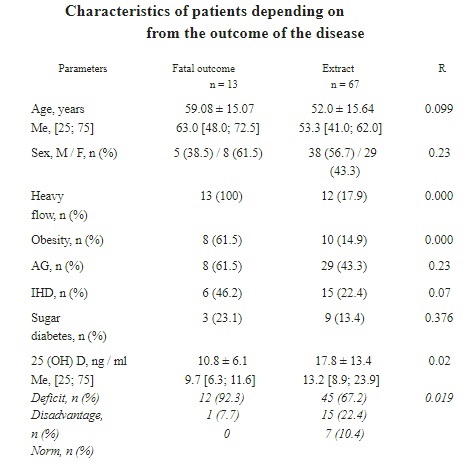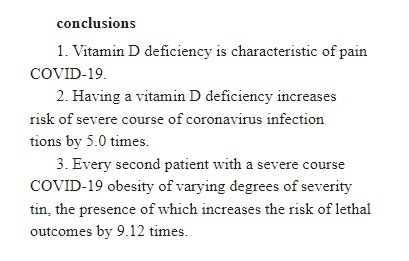Russian Hospital observed 5X more likely to have severe COVID-19 if Vitamin D Deficient
Serum 25(oH)D level in patients with CoVID-19
DOI: 10.22625/2072-6732-2020-12-3-21-27
T.L. Karonova 1 karonova@mail.ru, А.Т. Andreeva 1 arabicaa@gmail.com, М.А. Vashukova 2 mavashukova@yahoo.com
1 National Medical Research Centre named after V.A. Almazov, Saint-Petersburg, Russia
2 Clinical Infectious Hospital named after S.P. Botkin, Saint-Petersburg, Russia
COVID-19 treated by Vitamin D - studies, reports, videos
- {include}
Virus - Vitamin D Intervention in VitaminDWiki
{category}
Virus - Vitamin D Loading Dose in VitaminDWiki
{category}
📄 Download the Russian PDF from VitaminDWiki
Translations by Google Translate from the PDF



English Abstract
Recently, vitamin D deficiency is considered as a risk factor for the incidence and severity of new coronavirus infection. The aim of this work was to evaluate the vitamin D level of patients with COVID-19 hospitalized with communityacquired pneumonia and compare the value of 25(OH)D in blood serum with the clinical manifestations of the disease.
Results. Included are 80 patients aged 18 to 94 years (mean age 53,2 ± 15,7 years), 43 (53,8%) men; with severe
course – in 25 (31,3%) patients (12 males), and moderate – in 55 people (68,7%) (31 males). Half of the severely
ill patients were obese, and among the deceased patients, the number of obese people was 61,5%, which was significantly higher than the discharged ones – 14,9% (p<0,001). Diabetes mellitus and cardiovascular diseases occurred with the same frequency, regardless of the severity of the disease.
Analysis of the outcomes of coronavirus infection in these patients showed mortality in 52,0% of cases in severe patients.
Serum 25(OH)D level ranged from 3,0 to 88,8 ng / ml (16,7 ± 12,7 ng / ml). It was found that in patients with severe course, the level of 25(OH)D blood was significantly lower (11.9 ± 6.4 ng / ml) and vitamin D deficiency was more common than in patients with moderate to severe course of the disease (18,5 ± 14,0 ng / ml, p = 0,027). The same pattern was revealed in patients with a fatal outcome, where the level of 25(OH)D was 10,8 ± 6,1 ng / ml, compared with this indicator in patients discharged from the hospital (17,8 ± 13,4 ng / ml) (p = 0,02).
Conclusions. Vitamin D deficiency and obesity have been found to increase the risk of severe course and death of coronavirus infection.
